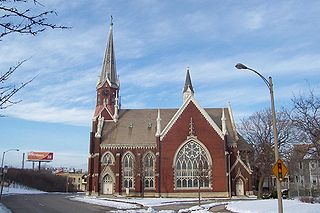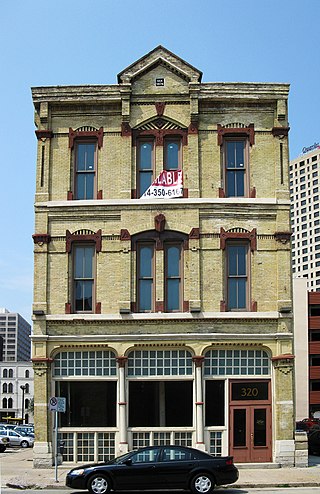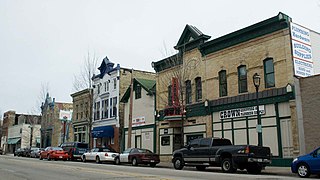
The Historic Third Ward is a historic warehouse district located in downtown Milwaukee, Wisconsin. This Milwaukee neighborhood is listed on the National Register of Historic Places. Today, the Third Ward is home to over 450 businesses and maintains a strong position within the retail and professional service community in Milwaukee as a showcase of a mixed-use district. The neighborhood's renaissance is anchored by many specialty shops, restaurants, art galleries and theatre groups, creative businesses and condos. It is home to the Milwaukee Institute of Art and Design (MIAD), and the Broadway Theatre Center. The Ward is adjacent to the Henry Maier Festival Park, home to Summerfest. The neighborhood is bounded by the Milwaukee River to the west and south, E. Clybourn Street to the north, and Lake Michigan to the east.

Trinity Evangelical Lutheran Church is a Victorian Gothic-style Lutheran church built in Milwaukee, Wisconsin in 1878 - then claimed to be "the finest church edifice within the Missouri Synod." Today it is listed on the National Register of Historic Places and is a designated State Historic Site. The building was also declared a Milwaukee Landmark in 1967, and today is the oldest church associated with the Lutheran Church–Missouri Synod in the city.

St. Stephen Lutheran Church, or Iglesia Luterana San Esteban, is a designated Milwaukee Landmark. It is in the historic Walker's Point district of Milwaukee, Wisconsin.

The Menomonee Valley or Menomonee River Valley is a U-shaped land formation along the southern bend of the Menomonee River in Milwaukee, Wisconsin. Because of its easy access to Lake Michigan and other waterways, the neighborhood has historically been home to the city's stockyards, rendering plants, shipping, and other heavy industry. It was also a primary source of pollution for the river.

The neighborhoods of Milwaukee include a number of areas in southeastern Wisconsin within the state's largest city at nearly 600,000 residents.

St. Peter's Evangelical Lutheran Church, or Iglesia Luterana San Pedro, is a historic church complex located in the Walker's Point neighborhood of Milwaukee, Wisconsin. Its buildings are listed on the National Register of Historic Places.

Washington Avenue Historic District is the historic center of Cedarburg, Wisconsin, the location of the early industry and commerce that was key to the community's development. The historic district was listed on the National Register of Historic Places (NRHP) in 1986.

Old St. Mary's Church in Milwaukee, Wisconsin was built in 1846 and 1847. The parish was founded a year earlier, by German Catholic immigrants. It was the proto-German church of the Archdiocese of Milwaukee. The city had been incorporated only the year before, and Wisconsin had not yet become a state. Old St. Mary's is the oldest church still standing in the city. The building was listed on the National Register of Historic Places in 1973.

The Church Hill Historic District is a mid-to-upper-class residential area north of Portage's downtown. It was added to the National Register of Historic Places in 1997 for its significance in architecture and social history.

The Wisconsin Leather Company Building was built in 1874 in Milwaukee, Wisconsin as the central office and store of one of the first leather companies established in Milwaukee and by the 1870s one of the largest. It was added to the National Register of Historic Places in 2005.

Charles F. Pfister was a wealthy tannery magnate, bank financier, utility owner, newspaper publisher, hotelier and philanthropist in Milwaukee, Wisconsin. He was also a central figure in the stalwart "Old Guard" of the Republican Party of Wisconsin during the rise of the state's progressive Republicans. Although never a political candidate himself, Pfister advised on tactics and used his vast holdings to fund the party's operations, dictate favored legislation, and re-edit the opinion pages of Wisconsin newspapers. A lifelong bachelor, Pfister belonged to many clubs and organizations but shunned the spotlight. He donated much of his fortune to local arts groups and charities.

The Port Washington Downtown Historic District is the largely intact remainder of the old commercial downtown of Port Washington, Wisconsin, United States. It consists of about 40 contributing buildings built from the 1850s to the 1950s in various styles. The district was added to the National Register of Historic Places in 2000 for significance to both architecture and the history of commerce.
Friedrich Vogel, more commonly known by the Americanized version of his name as Frederick Vogel, Sr., was an American tanner and businessman from Milwaukee, Wisconsin who spent a single one-year term as a member of the Wisconsin State Assembly. Together with his cousin Guido Pfister, he founded the Pfister & Vogel tannery.
Pfister & Vogel (P&V) was an American tannery business in Milwaukee, Wisconsin.

August Hugo Vogel (1862–1930) was vice-president of Pfister & Vogel leather tannery of Milwaukee, Wisconsin.
The West Washington-North Hi-Mount Boulevards Historic District is a historic neighborhood in Milwaukee, Wisconsin, with stylish homes built along the named streets beginning in 1912, mostly businessmen and professionals. In 1994 the district was listed on the National Register of Historic Places.

The Main Street Historic District is a cluster of historic buildings around the intersection of Main Street and Appleton Avenue in Menomonee Falls, Wisconsin. It was added to the National Register of Historic Places in 1988.

The Mazomanie Downtown Historic District is the old downtown of Mazomanie, Wisconsin, with surviving structures built as early as 1857. It was added to the State and the National Register of Historic Places in 1992.

The North Third Street Historic District is a somewhat intact business district on the near north side of Milwaukee, Wisconsin, with a wide range of surviving buildings going all the way back to 1854. It was listed on the National Register of Historic Places in 1984 and on the State Register of Historic Places in 1989.

The Old World Third Street Historic District is the last relatively intact part of the original German retail district in Milwaukee, Wisconsin's Kilbourntown plat, containing examples of various styles of Victorian commercial architecture going back to 1855. It was listed on the National Register of Historic Places in 1987 and on the State Register of Historic Places in 1989.


















